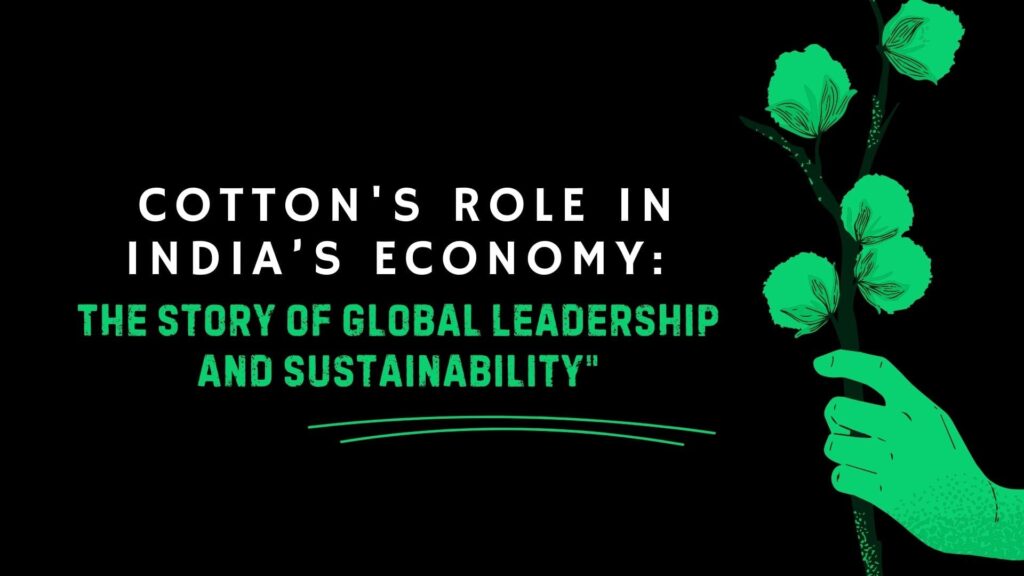Cotton has long been woven into the fabric of India’s economy, playing a crucial role in agriculture, manufacturing, and trade. As one of the world’s largest producers of the cotton plant, India not only meets domestic demands but also significantly contributes to global markets. Furthermore, the process of cotton cultivation ensures a high-quality supply. This blog explores the multifaceted role of cotton in India’s economy, highlighting its journey toward global leadership and sustainability.
A Historical Perspective
To begin with, cotton cultivation in India dates back thousands of years, with evidence found in ancient texts and archaeological sites. Indeed, the Indian subcontinent is often regarded as the birthplace of cotton, and its rich traditions in weaving and textile production have been passed down through generations. Moreover, British colonial rule in the 19th century further integrated cotton into global trade networks, thereby setting the stage for its importance in India’s economy.
Economic Significance of Cotton
1. Agricultural Backbone
Firstly, cotton serves as a major cash crop for Indian farmers, providing livelihoods to over 60 million people across the country. It thrives in various states, including Gujarat, Maharashtra, and Punjab, thus contributing significantly to the rural economy. Additionally, this crop supports farmers’ incomes and drives ancillary industries, such as ginning and spinning.
2. Textile Industry Powerhouse
Furthermore, India boasts one of the largest textile industries globally, with cotton as a primary raw material. In fact, the textile sector contributes around 2-3% to the country’s GDP and accounts for 14% of total industrial production. With a diverse range of products—from garments to home textiles—India’s textile industry undeniably plays a significant role in the global market.
3. Export Leader
In addition to its domestic significance, India ranks among the top exporters of cotton and cotton products, substantially contributing to the country’s foreign exchange reserves. The demand for Indian cotton in international markets stems from its quality, affordability, and the reputation of Indian textiles. Major export destinations include the United States, China, and several European countries.
Global Leadership in Cotton Production
India demonstrates its commitment to becoming a global leader in cotton production through various initiatives and advancements in agricultural practices:
1. Technological Innovations
For instance, farmers adopt genetically modified (GM) cotton varieties, which increase yields and reduce dependency on pesticides. In addition, they implement precision agriculture techniques to optimize resource use and enhance productivity.
2. Government Support
Moreover, various government schemes and policies support cotton farmers, including price support, subsidies, and access to credit. For instance, the “Pradhan Mantri Fasal Bima Yojana” (PMFBY) protects farmers against crop failures, thereby ensuring their economic stability.
3. Sustainability Initiatives
Recognizing the environmental challenges associated with cotton farming, India increasingly focuses on sustainable practices. In this context, the promotion of organic cotton farming, water conservation techniques, and integrated pest management represents essential components of this shift toward sustainability.
Sustainability and Ethical Practices
As global consumers become more conscious of sustainability and ethical practices, the Indian cotton industry responds to these demands:
1. Organic Cotton Production
For example, India leads in organic cotton production, catering to the growing market for sustainably sourced materials. This practice not only promotes environmental health but also benefits farmers by granting them access to premium markets.
2. Fair Trade Practices
Furthermore, initiatives supporting fair trade practices gain traction, ensuring farmers receive fair compensation for their produce. Organizations actively work to enhance transparency in the supply chain, thereby promoting ethical sourcing of cotton.
3. Water Management
Given the water-intensive nature of cotton cultivation, sustainable water management practices gain emphasis. Techniques such as rainwater harvesting and drip irrigation increasingly optimize water use and minimize environmental impact.
Challenges Facing the Cotton Industry
While cotton remains vital to India’s economy, it also faces several challenges:
1. Climate Change
To illustrate, climate change impacts weather patterns, affecting cotton yields and quality. Consequently, unpredictable rainfall and extreme temperatures pose risks to production.
2. Market Fluctuations
Additionally, cotton prices can be volatile, influenced by global demand, trade policies, and competition from synthetic fibers. As a result, farmers often face financial uncertainty due to these market fluctuations.
3. Sustainability Concerns
Traditional cotton farming practices have a significant environmental impact, primarily due to pesticide use and soil degradation. This situation has led many to advocate for more sustainable methods of cultivating the cotton plant. Addressing these challenges is essential not just for the health of the industry, but also for the wellbeing of our planet and future generations.
The Future of Cotton in India
Looking ahead, the future of cotton in India appears both promising and challenging.
1. Innovation and Research
Continued investment in research and development proves essential to improving cotton varieties and farming techniques. This includes developing climate-resilient crops that can withstand changing environmental conditions.
2. Sustainable Practices
Additionally, emphasizing sustainable farming practices enhances the quality of cotton plant and ensures the industry aligns with global sustainability goals. Collaboration between farmers, industries, and government bodies proves critical in this regard.
3. Global Partnerships
Finally, strengthening partnerships with international markets can open new avenues for Indian cotton, boosting exports and enhancing competitiveness in the global arena.
In conclusion, cotton’s role in India’s economy represents a story of resilience, innovation, and sustainability. As the country strives to be a global leader in cotton production, focusing on sustainable practices and ethical sourcing will prove crucial. By embracing technological advancements and prioritizing farmers’ welfare, India can secure its place in the global cotton market while ensuring the legacy of the cotton plant remains sustainable and prosperous. Ultimately, understanding how to cultivate cotton plants for maximum yield and quality is vital for stakeholders navigating this evolving landscape. With innovation and collaboration, the cotton industry can thrive and create a sustainable future for millions who depend on it.

